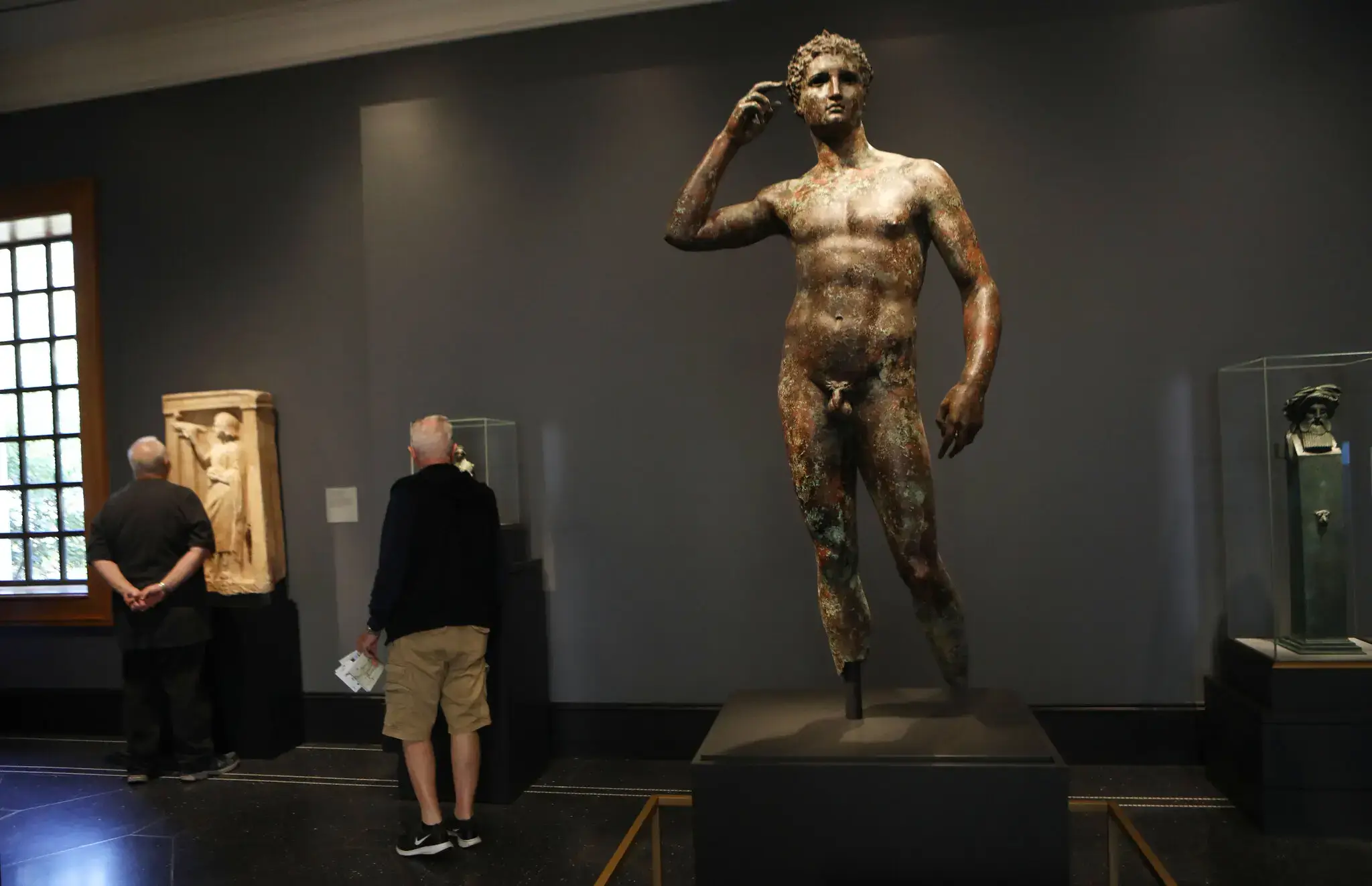The European Court of Human Rights has found that Italy’s claims to a contested Greek statue are legitimate. But the museum says its continued possession is appropriate and lawful.
The European Court of Human Rights on Thursday upheld Italy’s right to confiscate a contested ancient Greek statue on display in the J. Paul Getty Museum in California.
It ruled that in trying to recover the artifact, the Italian authorities had “acted with the purpose of recovering an unlawfully exported piece of cultural heritage.”
The ruling rejected the appeal of the J. Paul Getty Trust, which had asked the European Court of Human Rights to weigh in on the case after Italy’s highest court in 2018 ruled that the Getty had to return the statue to Italy.
In a statement on Thursday, the Getty said it believed its “nearly 50-year possession” of the bronze was “appropriate, ethical and consistent with American and international law” and that if necessary, it would “continue to defend its possession of the statue in all relevant courts.”
The Getty identifies the life-size bronze sculpture, which dates between the second or third century B.C., as a “Victorious Youth.” But in Italy, it is known as the “Athlete of Fano,” for the small seaside town on the Adriatic off whose waters Italian fishermen discovered the statue in 1964.
Italians officials assert that it was illegally smuggled out of Italy and passed onto the international art market, where the Getty bought it for about $4 million in 1977.
At the time, Italy had already attempted to claim the statue from a German dealer on the art market, unsuccessfully.
The statue, widely held to be one of the finest original Greek bronzes to have survived from the classical era (most bronzes from that time are Roman copies), has been at the heart of a complex legal dispute for decades.
In recent years, Italy has managed to recover hundreds of artifacts illegally looted from its antiquities-rich soil, a felicitous convergence of efforts by its crack art theft squad and other investigators, court decisions and public diplomacy.
But the Getty has held fast against Italian claims to the statue, arguing that it had been fashioned in ancient Greece and found in international waters, and that the museum had acted in good faith when it bought the piece.
Italy counterclaimed that after being found by Italian fishermen, it had been exported illegally from Italy. It questioned the Getty’s good faith.
In its 2018 ruling, Italy’s highest court said the work should be confiscated and returned to Italy, upholding a lower court’s confiscation order.
CLICK HERE TO READ MORE FROM THE REPUBLICAN VOICE
In response, the Getty had turned to the European court, which is based in Strasbourg, France, arguing that its rights to the statue had been violated under a European human rights protocol on protection of property.
The court is a tribunal of the Council of Europe and rules on cases where there are accusations that civil or political rights have been violated by member states who have agreed to accept its jurisdiction. Thursday’s judgment was given by seven judges from various countries.
In the ruling, the court found that no violation by Italy had occurred.
“It couldn’t have gone any other way,” said Lorenzo D’Ascia, a lawyer for the Italian government involved in the case. He noted that the European court had affirmed that there was international consensus about the need to protect cultural artifacts from looting.
The ruling also upheld the legitimacy of confiscating illicitly gotten works and returning them to their country of origin. “It’s an important ruling,” he said.
The relationship between the Getty and Italian culture officials has long been fraught.
Marion True, a Getty curator who with another curator, Jiri Frel, had helped to build one of the top collections of ancient art in the United States, was put on trial in Rome in 2005, accused of receiving artifacts stolen from Italy and conspiring to deal in them.
The case against True ended abruptly in 2010, after a court ruled that the statute of limitations on her alleged crimes had expired.
While the case was in court, Italy began negotiating with the Getty for the return of some of the works it identified as looted. The talks were contentious, and at one point stalled because of the statue.
A first accord with the museum was reached in September 2007, when the Getty agreed to return 40 antiquities claimed by Italy, though the statue was excluded from the negotiations.
Since then, the Getty has returned numerous artifacts claimed by Italy, including three terra-cotta figures depicting “Orpheus and the Sirens,” dating to around 300 B.C. that caused a stir in Italy when they were returned two years ago.
Thursday’s ruling was a so-called chamber judgment and not final. Either party has three months to request that the case be referred to the Grand Chamber of the European court to consider whether it deserved further examination.
“But the cases where they pass to the Grand Chamber are rare,” said D’Ascia, the lawyer. The Getty said Thursday that it was “carefully considering the possibility of requesting a review before the Grand Chamber.”
A confiscation order from the Italian court dating to 2019 had been suspended to await the decision of the European court.
Should Thursday’s ruling stand, the U.S. Department of Justice will be asked to evaluate whether the Italian request is admissible, and in that case, it would argue the case on behalf of Italy in a California court.
CLICK HERE TO READ MORE FROM THE REPUBLICAN VOICE
In a statement, Gennaro Sangiuliano, Italy’s culture minister, said that the country would “pursue with renewed determination its actions” to have “the statue brought back to Italy.”
Last week in a separate case, the Getty announced it was returning an ancient bronze head to Turkey after concerns were raised that it had been looted.























